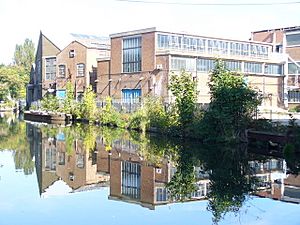Nash Mill facts for kids
Nash Mill was once a famous paper factory located in Hemel Hempstead, Hertfordshire, United Kingdom. The area around it, called Nash Mills, got its name from this important mill.
Contents
A Mill with a Long History
Nash Mill has a very long history! It was first mentioned as a corn mill (a mill for grinding grain) in the ancient Domesday Book. This book was like a big survey of England made almost 1,000 years ago. During the Middle Ages, the mill belonged to the Abbey of St Albans.
Becoming a Paper Factory
John Dickinson Buys the Mill
In 1811, a smart businessman named John Dickinson bought the mill. Before he bought it, the mill had already started making paper. This change happened in the late 1700s. Nash Mill was only about half a mile from Dickinson's first factory, Apsley Mill. Both mills were located near the Grand Junction Canal.
A Family Business and Special Paper
The mill-house, called Nash House, became the home for John Dickinson and his new wife, Ann. Ann's father, Harry Grover, helped Dickinson with his business plans. His bank, Grover's Bank, supported the new paper factory. Soon, Nash Mill became well-known for making strong, thin paper. This special paper was used for Samuel Bagster's "Pocket Reference Bible."
Overcoming Challenges and Growing
In 1813, a big fire caused a setback for the mill. Luckily, the damage was covered by insurance. This allowed the mill to rebuild and become even bigger. By 1825, they had installed steam power. Coal for the steam engines was brought in by the canal.
Engineering and New Ideas
The company, John Dickinson & Co. Ltd, had its Engineering Department at Nash Mills. This department stayed there until 1888. After that, it moved to Apsley Mill. Nash Mill was also famous for making fine paper from rags. They used new electric machines, which was a very successful idea at the time.
Worker Challenges
In 1821, there were some problems with the workers. Their pay was cut because the paper business was slowing down. Leaders of the local Society of Papermakers were fired. New workers were brought in from Abbots Langley. The fired workers and their families faced hard times. Some even had to rely on help from the local community. After some arguments and even a bit of damage to the mill, things eventually settled down.
Keeping Things Running
The mill sometimes had mechanical problems. For example, in 1823 and 1826, there were repeated issues with the machinery. Nash Mill even had its own fire brigade. They had a steam fire engine ready to put out any fires.
Changes Over Time
By the end of the 1800s, Nash Mill was smaller than other factories. It was known for being independent. However, it started to make less money. Many small changes were made over the years. Then, in 1926, the mill got a big upgrade. It was expanded, redesigned, and made new again.


